The first part of this little white paper sort of thing was written to dispell some mistaken ideas about detuned speaker designs. Those who are already comfortable with Q's, V's and other thingies (a technical term), feel free to skip the first part. But I thought the folks here might be more interested in the second part, where real numbers happen.
=====
Speakers, or more accurately, the drivers (which along with an enclosure make up a speaker) have physical and acoustic characteristics according to their design and construction. These characteristics can be used to determine how and what size of an enclosure will produce a desired result, such a flat response, accentuated bass response, etc. When a speaker is constructed according to these parameters, with an internal volume that best produces the desired result, it is considered to be “tuned”. The simplest of these is an entirely closed enclosure. Some designs call for a small opening called a vent, usually with a tube that extends into the enclosure. This is called a tuned port. In both this design, and the previous, the tuning depends on matching the internal volume to the characteristics of the drivers. The wrong size of enclosure, the wrong size port, or replacing one of more drivers from a tuned speaker with one or more with different characteristics results in a poorly tuned speaker.
Some speakers, particularly those in guitar “combo” amplifiers (combined amplifier and speaker) are open in back. The back side of the drivers are open to the air. The internal volume effectively becomes infinite. Such a design has no tuning involved, and is considered “detuned”. Although there is no optimization of the speaker involved, in a speaker of this type there is typically much control over the signal to make it sounds as desired, as well as being noticeably louder than other designs due to sound from the back side of the driver being able to freely escape the enclosure.
Some have come to consider that a guitar speaker enclosure with half the drivers removed (one of two, or two of four) to be detuned. This is only partially accurate. To be truly detuned, the area of opening to let the “rear” sound escape should be larger than that of the drivers. A 12” driver has an area of 113 square inches. To be truly detuned the back side must have an open area greater than this. The actual size of the enclosure is irrelevant, only the driver and the size of the open back matter. Too small a “rear” opening and there will be resonance effects, emphasizing some frequencies and dampening others.
The term “detuned” has also been used to describe a design with the “rear” opening being redirected by the enclosure towards the front, producing more volume being directed towards the listeners. If constructed with the proper opening size, this design is detuned, but detuned does not necessarily mean this redirection takes place. It's simply a very good idea, and is the basis for having half the driver mounting holes left open in a regular speaker.
Many very detailed detuned designs have been attempted, some with adequate reasoning, others simply a matter of convenience or taste. The fact is the design requires little more than the rear opening area being larger than the driver area. I attempted to produce a minimal detuned design as a proof of concept test of this point. The “enclosure” consisted solely of a 12” plastic bowl, a 12” x 24” x 1/2” sheet of “expanded metal” steel grating, and appropriate fasteners and wiring. The driver was an 8” GRS “BOFU” clone.
[See picture 1]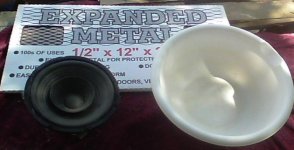
The driver was attached to the grill,
[See pictures 2 and 3]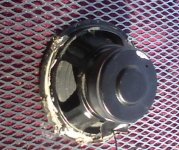
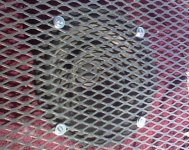
which was then suspended from a horizontal bar by hooks made of stiff wire.
[As in picture 5]
The back was left open to the air, outdoors, to minimize reflected sound affecting measurements.
A 1kHz sine wave tone was generated by computer and amplified to 1 watt (measured as 2.8 volts in parallel with the 8 ohm driver impedance). The volume of the sound produced was measured with a hand held SPL meter held 1 meter away from the center of the driver, on axis, integrated over the 30 second duration of the tone.
The driver is rated at 91 dB for this measure. The measurement on this driver and configuration was 93 dB. This is well in keeping with the fact that manufacturers often state parameters conservatively in case a particular piece does not perform as well as intended. I have obtained slightly higher than stated response from these drivers in other tests.
The driver/grill assembly was then attached to the lip of the bowl. The driver was positioned off-center to minimize resonance effects. The 8” driver has a frontal area of 50 square inches, and the bowl 113 square inches. The difference, 63 square inches for the “rear” opening is approximately 25% greater than the driver's area.
This assembly was then hung in the same manner as for the first test.
[See pictures 4 and 5]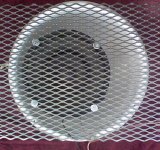
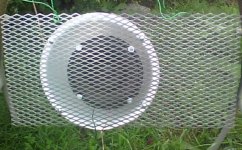
The same signal at the same power level was tested in the same manner. The response of the system in this detuned, forward facing output was 101 dB. Both theoretical and measured increases in response for detuning a given speaker is 3 to 6 dB. I speculate that this greater improvement, nearly double the volume, was due to the use of an approximately hemispherical reflector held in close proximity and nearly surrounding the driver from the mounting flange down. (Driver depth, flange to bottom of magnet = 3.875”; bowl depth 4.5”).
In any case, I believe this demonstration (NOT an experiment – there are important differences) supports the concept of detuned enclosures for greater SPL output from a given driver configuration. Also, not only is a minimal rear enclosure space adequate, it may be beneficial if configured to produce greater response.
Questions welcomed: threesigma@rocketmail.com
Dr. Dennis McClain PhD
“I am a scientist, but I don't play one on TV.”
=====
Speakers, or more accurately, the drivers (which along with an enclosure make up a speaker) have physical and acoustic characteristics according to their design and construction. These characteristics can be used to determine how and what size of an enclosure will produce a desired result, such a flat response, accentuated bass response, etc. When a speaker is constructed according to these parameters, with an internal volume that best produces the desired result, it is considered to be “tuned”. The simplest of these is an entirely closed enclosure. Some designs call for a small opening called a vent, usually with a tube that extends into the enclosure. This is called a tuned port. In both this design, and the previous, the tuning depends on matching the internal volume to the characteristics of the drivers. The wrong size of enclosure, the wrong size port, or replacing one of more drivers from a tuned speaker with one or more with different characteristics results in a poorly tuned speaker.
Some speakers, particularly those in guitar “combo” amplifiers (combined amplifier and speaker) are open in back. The back side of the drivers are open to the air. The internal volume effectively becomes infinite. Such a design has no tuning involved, and is considered “detuned”. Although there is no optimization of the speaker involved, in a speaker of this type there is typically much control over the signal to make it sounds as desired, as well as being noticeably louder than other designs due to sound from the back side of the driver being able to freely escape the enclosure.
Some have come to consider that a guitar speaker enclosure with half the drivers removed (one of two, or two of four) to be detuned. This is only partially accurate. To be truly detuned, the area of opening to let the “rear” sound escape should be larger than that of the drivers. A 12” driver has an area of 113 square inches. To be truly detuned the back side must have an open area greater than this. The actual size of the enclosure is irrelevant, only the driver and the size of the open back matter. Too small a “rear” opening and there will be resonance effects, emphasizing some frequencies and dampening others.
The term “detuned” has also been used to describe a design with the “rear” opening being redirected by the enclosure towards the front, producing more volume being directed towards the listeners. If constructed with the proper opening size, this design is detuned, but detuned does not necessarily mean this redirection takes place. It's simply a very good idea, and is the basis for having half the driver mounting holes left open in a regular speaker.
Many very detailed detuned designs have been attempted, some with adequate reasoning, others simply a matter of convenience or taste. The fact is the design requires little more than the rear opening area being larger than the driver area. I attempted to produce a minimal detuned design as a proof of concept test of this point. The “enclosure” consisted solely of a 12” plastic bowl, a 12” x 24” x 1/2” sheet of “expanded metal” steel grating, and appropriate fasteners and wiring. The driver was an 8” GRS “BOFU” clone.
[See picture 1]

The driver was attached to the grill,
[See pictures 2 and 3]


which was then suspended from a horizontal bar by hooks made of stiff wire.
[As in picture 5]
The back was left open to the air, outdoors, to minimize reflected sound affecting measurements.
A 1kHz sine wave tone was generated by computer and amplified to 1 watt (measured as 2.8 volts in parallel with the 8 ohm driver impedance). The volume of the sound produced was measured with a hand held SPL meter held 1 meter away from the center of the driver, on axis, integrated over the 30 second duration of the tone.
The driver is rated at 91 dB for this measure. The measurement on this driver and configuration was 93 dB. This is well in keeping with the fact that manufacturers often state parameters conservatively in case a particular piece does not perform as well as intended. I have obtained slightly higher than stated response from these drivers in other tests.
The driver/grill assembly was then attached to the lip of the bowl. The driver was positioned off-center to minimize resonance effects. The 8” driver has a frontal area of 50 square inches, and the bowl 113 square inches. The difference, 63 square inches for the “rear” opening is approximately 25% greater than the driver's area.
This assembly was then hung in the same manner as for the first test.
[See pictures 4 and 5]


The same signal at the same power level was tested in the same manner. The response of the system in this detuned, forward facing output was 101 dB. Both theoretical and measured increases in response for detuning a given speaker is 3 to 6 dB. I speculate that this greater improvement, nearly double the volume, was due to the use of an approximately hemispherical reflector held in close proximity and nearly surrounding the driver from the mounting flange down. (Driver depth, flange to bottom of magnet = 3.875”; bowl depth 4.5”).
In any case, I believe this demonstration (NOT an experiment – there are important differences) supports the concept of detuned enclosures for greater SPL output from a given driver configuration. Also, not only is a minimal rear enclosure space adequate, it may be beneficial if configured to produce greater response.
Questions welcomed: threesigma@rocketmail.com
Dr. Dennis McClain PhD
“I am a scientist, but I don't play one on TV.”
Thanks for sharing this.
When I build an amp for someone else I ask them to supply the speaker they wish to use first.
Is the increase in SPL constant throughout the guitar frequency range (inc harmonics)?
When I build an amp for someone else I ask them to supply the speaker they wish to use first.
Is the increase in SPL constant throughout the guitar frequency range (inc harmonics)?
I honestly don't know the answer to your question as I have not tested for this. However due to a large number of factors (resonance effects, comb filter effects, environmental reflection/absorbtion, constructive/destructive interference) all of which are changing by the millisecond with the dynamics of the wide band complex signal, real world acoustics rarely behave according to the generalized perfect-world theoretics that even many engineers rely on. The term "chaos" applies, in the sense of complex dynamic systems theory, the "butterly effect" notion. While there might occasionally arise a significant resonance effect, it'd almost certainly be very transitory, and would happen about as often as a butterfly flapping its ... you know the rest.
I have tested some detuned PA towers and central unit I built
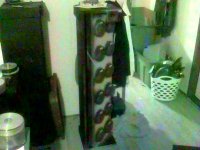
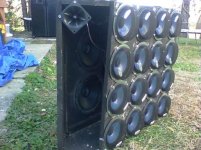
with stepped octave testing (62.5 Hz to 16 kHz) and found only a slight bass boost (+3 dB =< 250 Hz) due possibly to floor reflection. A more honest test would be to use a tone sweep but my analog SPL meter integrates way too slow.
I have tested some detuned PA towers and central unit I built


with stepped octave testing (62.5 Hz to 16 kHz) and found only a slight bass boost (+3 dB =< 250 Hz) due possibly to floor reflection. A more honest test would be to use a tone sweep but my analog SPL meter integrates way too slow.
The first part of this little white paper
I noticed that you didn't get too much interest, so I will add my comments. I have been building amps and other electronics of all sorts for about 50 years. I have a MSEE, and was about 2 years (part time) into an EE PHD but a company policy change cancelled the funding and ended that 10 years ago. My speaker building knowledge is best described as "rookie" level. I found the first part very interesting, and am looking forward to part 2.
Is the increase in SPL constant throughout the guitar frequency range
My guess is that the "boost" will drop off at lower frequencies because the plastic bowl will begin to vibrate. The next time my wife is out of town for the weekend I must try a plastic bowl VS stainless steel bowl "uncontrolled experiment". I have an MLS system with a calibrated microphone that uses FFT for some rather quick measurements.
Are the 16 blue drivers the Sony's from Parts Express?
I noticed that you didn't get too much interest, so I will add my comments. I have been building amps and other electronics of all sorts for about 50 years. I have a MSEE, and was about 2 years (part time) into an EE PHD but a company policy change cancelled the funding and ended that 10 years ago. My speaker building knowledge is best described as "rookie" level. I found the first part very interesting, and am looking forward to part 2.
Have you ever this phrase 'detuned'?
I never have, and the entire thread seems remarkably pointless, simply not mounting a speaker in box? - bizarre.
In the VERY early days mounting speakers on baffle boards was normal, with the larger the board the better - hence the name 'infinite baffle' for a sealed box.
I noticed that you didn't get too much interest, so I will add my comments. I have been building amps and other electronics of all sorts for about 50 years. I have a MSEE, and was about 2 years (part time) into an EE PHD but a company policy change cancelled the funding and ended that 10 years ago. My speaker building knowledge is best described as "rookie" level. I found the first part very interesting, and am looking forward to part 2.
.....
My guess is that the "boost" will drop off at lower frequencies because the plastic bowl will begin to vibrate. The next time my wife is out of town for the weekend I must try a plastic bowl VS stainless steel bowl "uncontrolled experiment". I have an MLS system with a calibrated microphone that uses FFT for some rather quick measurements.
Are the 16 blue drivers the Sony's from Parts Express?
Thanks for the bump. Sometimes few replies means the original was clear enough to get its point across. And, when numbers are involved, you need more numbers to argue it. At 137 reads so far I suspect I was understood and it was simply accepted. But I must apologize for being unclear: this was both parts. First was the descriptive about detuning, the second was the demonstration.
I agree the plastic might absorb some, particularly lower down. But then it was physically attached to the grill, and that to the driver, all of which was suspended. In this way it would absorb, vibrate, and have no choice to re-emit, somewhat like a passive radiator. I'd hoped this would minimize any absorbtion effect. The bowl was, after all, very much the same material as went into the cones of the Sony speakers you recognized in the pictures.
Yes, the blue speakers were P.E.'s Sony buy-outs. I went through around 100 of them before they ran out. The central unit is a "Sweet 16" array, plus there's a pair of their Goldwood 10" poly subs tucked away in the rear corner. There are 12 more of the Sonys in each of the towers in a 2x6 array and two piezo tweeters on each unit. For $150 in drivers and $50 in wood I built a PA rated at 620 Wrms. I love those Sonys. They make great replacements for the Jensen woofers in Mini-Advents. I've used them in Karlson K-tubes, underneath some JVC copies of the old Zenith Circle Of Sound style inverse parabolic reflectors, even mounted in old outdoor floodlight fixtures. Great stuff. I was sad to see them go.
Good luck with your test, and in coming up with the reason the bowls went missing.
Have you ever this phrase 'detuned'?
I never have, and the entire thread seems remarkably pointless, simply not mounting a speaker in box? - bizarre.
Kevin O'Connor has made a very big deal of it in his books.
The word "detuned" means different things to different people. In my engineering world, it's an RF circuit that isn't resonating at the right frequency. I am a transmitter designer in a Motorola plant.
In this context it appears to mean a cabinet that is deliberately tuned to a non optimum frequency, or a cabinet with a large opening such that there is no sharp resonance caused by box tuning.
Agreed. Look at all the large console radios made from the 1920's through the early 1950's. The cabinets had no backs, but gained some suppression of the back side wave from the cabinet sides. Room placement was a major factor. I have some modern drivers (Hawthorne Silver Iris) mounted in a pair of 1941 vintage console radios for my living room system. The woofer must be designed for open baffle use otherwise it won't sound right. Room placement is still critical.
Most combo guitar amps had a back that was too small to make an effective closed cabinet. These designs were primarilly cost driven, and the speakers of the day were rather stiff.
I believe Dennis did this to make a point. A speaker in an open ended box was, and still is a valid option. If someone want's to take the time to figure out the science behind such a system, good, some of us can benefit from the knowledge.
In this context it appears to mean a cabinet that is deliberately tuned to a non optimum frequency, or a cabinet with a large opening such that there is no sharp resonance caused by box tuning.
In the VERY early days mounting speakers on baffle boards was normal, with the larger the board the better
Agreed. Look at all the large console radios made from the 1920's through the early 1950's. The cabinets had no backs, but gained some suppression of the back side wave from the cabinet sides. Room placement was a major factor. I have some modern drivers (Hawthorne Silver Iris) mounted in a pair of 1941 vintage console radios for my living room system. The woofer must be designed for open baffle use otherwise it won't sound right. Room placement is still critical.
Most combo guitar amps had a back that was too small to make an effective closed cabinet. These designs were primarilly cost driven, and the speakers of the day were rather stiff.
simply not mounting a speaker in box? - bizarre.
I believe Dennis did this to make a point. A speaker in an open ended box was, and still is a valid option. If someone want's to take the time to figure out the science behind such a system, good, some of us can benefit from the knowledge.
Attachments
Nigel, it is rather an odd argument to be critical of something about you admit complete ignorance. No doubt you used a web browser to post that, the same browser you could have used to do a search for the term elsewhere, including the book about it, Kevon O'Connor's "DIY Speaker Cabinets for Musical Applications". You'd find a few meaningful articles, and about 100 instances of people using the term to describe a half-filled multi-driver system. It's the latter that is the reason I wrote this. If you think the point was not mounting a speaker in a box, you didn't read it well. In this paper, the bowl *was* the "box", and a baffle would have been a confound as the stated intention was to minimize the size and measure only the driver and the effect of the detuned enclosure. If you read what I wrote, as well as O'Connor's book and the many postings available on the web, I think you'll better understand what I wrote and why I wrote it.
The word "detuned" means different things to different people.
Indeed, in musical instrument applications it has two. One is the topic here, the other is purposely changing the tuning on the instrument to something other than the common standard. In guitars, it is common to tune to "standard" tuning (EADGBe) then lower the E one note to D. This is called "drop D" tuning. In bluegrass and similar music "mashing in B" refers to changing to a B based tuning (banjos are typically tuned in G) for the purpose of playing hard. Can't explain that one better as I'm not a banjo player, but I play with many on The Crooked Road. I myself tune my resonator guitar to DADDAD for slap playing, or for playing slide as the use of all key note and fifths make both major and minor equally accessible. It can also mean simply out of tune, but I've never heard anything other than out of tune used for this. Except maybe "d00d! you need to tune your axe, man!"
Detune is half of music. De other half is delyrics. Don't detune detune or delyrics, or they'll show you dedoor, Sorry, couldn't stop myself.
I have been attempting to play guitar for over 50 years, so I know about drop tuning. In fact my parents gave me an electric guitar when I was 7 years old. I had no amp though.....thats what started this nonsense.
I never actually googled "detuned" before so I tried it. I found this one, that is close to what I was trying to say.
"To change the inductance or capacitance of a tuned circuit so its resonant frequency is different from the incoming signal frequency."
Sometimes in EE work circuits are purposefully detuned to accentuate some electrical property. Often multiple cascaded tuned circuits are detuned to increase the total bandwidth. This is called stagger tuning.
This was once done with multiple tuned elements each detuned a bit from the center frequency. Common in old tube type TV sets. A sweep generator and a scope was required to plot the response and tune the system. Now the same thing happens inside an integrated filter system, like a SAW (surface acoustic wave) filter. Common in new TV's and cell phones. The system is tuned once in a computer model when the system is designed. Each filter is identical by design.
I never actually googled "detuned" before so I tried it. I found this one, that is close to what I was trying to say.
"To change the inductance or capacitance of a tuned circuit so its resonant frequency is different from the incoming signal frequency."
Sometimes in EE work circuits are purposefully detuned to accentuate some electrical property. Often multiple cascaded tuned circuits are detuned to increase the total bandwidth. This is called stagger tuning.
This was once done with multiple tuned elements each detuned a bit from the center frequency. Common in old tube type TV sets. A sweep generator and a scope was required to plot the response and tune the system. Now the same thing happens inside an integrated filter system, like a SAW (surface acoustic wave) filter. Common in new TV's and cell phones. The system is tuned once in a computer model when the system is designed. Each filter is identical by design.
I'd been familiar with detuned circuits for some time. I started out testing tubes in my dad's TV shop in 1962 and got my own job at another shop in 1968. During this time I built my own guitar amp from an old TEAC reel to reel, removing the busted mechanical unit and using the internal audio amp. I used it for years with that big weird shaped hole in front where the mechanism was. Yeah, I got familiar with the sweep generator and scope.
Weird thing I just remembered. My dad showed my images on the scope that were inserted into the blanking interval on TV signals. WGN in Chicago inserted an image of Wrigley Tower and the ABC affiliate inserted an image of the Hancock building, in both instances it was where their transmitting tower was located.
Anyway, I believe Karlson speaker designs are also detuned, but the detuning happens in a frequency and spatial dependent manner due to the exponetial curve opening. I've built Karlson Klams and K-tubes to study this.
8" BOFU based Klam
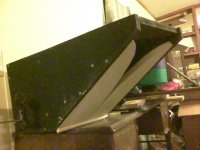
4" K-tubes under construction (yes, with the Sony's)
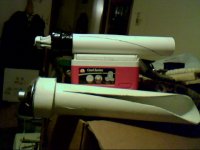
You may recognize a similarlity between Karlson's K-tube and some open end waveguide antennae. He directly applied the acoustic design and patented the waveguide. Very well known in microwave use, I believe. He also patented a jet engine silencer based on the design, and I'm pretty certain you can see the rectangular version, the Klam design, on the exhaust nozzles of the B-2 bomber.
Very interesting thing came about when playing with K-tubes and the Sony's. I put two in a short tube, front to back, in an isobaric configuration ("compound woofer system" in Dickason's book), shoved the output into a K-tube and sealed the rear. I put a mono signal into them and heard the depth effect they're know for. I then put one of stereo channels into each (the bass being pretty much mono anyway, the reinforcement effect still occuring) and heard not only the depth but the stereo spead also. To make sure I showed it to two other people without telling them what to expect, and they heard the same.
I just love such psychoacoustic illusions. I wish I had the time to explore all of them. Alas, luthier work and practicing/performing produce income and solitary science does not. It may, whoever, result in a million dollar gee-i-wish-I'd-thought-of-that simple but effective idea that I can patent and license. I've come up with several, but someone else had the same idea before me. That doesn't mean I was wrong, just not first. So I persist.
Weird thing I just remembered. My dad showed my images on the scope that were inserted into the blanking interval on TV signals. WGN in Chicago inserted an image of Wrigley Tower and the ABC affiliate inserted an image of the Hancock building, in both instances it was where their transmitting tower was located.
Anyway, I believe Karlson speaker designs are also detuned, but the detuning happens in a frequency and spatial dependent manner due to the exponetial curve opening. I've built Karlson Klams and K-tubes to study this.
8" BOFU based Klam

4" K-tubes under construction (yes, with the Sony's)

You may recognize a similarlity between Karlson's K-tube and some open end waveguide antennae. He directly applied the acoustic design and patented the waveguide. Very well known in microwave use, I believe. He also patented a jet engine silencer based on the design, and I'm pretty certain you can see the rectangular version, the Klam design, on the exhaust nozzles of the B-2 bomber.
Very interesting thing came about when playing with K-tubes and the Sony's. I put two in a short tube, front to back, in an isobaric configuration ("compound woofer system" in Dickason's book), shoved the output into a K-tube and sealed the rear. I put a mono signal into them and heard the depth effect they're know for. I then put one of stereo channels into each (the bass being pretty much mono anyway, the reinforcement effect still occuring) and heard not only the depth but the stereo spead also. To make sure I showed it to two other people without telling them what to expect, and they heard the same.
I just love such psychoacoustic illusions. I wish I had the time to explore all of them. Alas, luthier work and practicing/performing produce income and solitary science does not. It may, whoever, result in a million dollar gee-i-wish-I'd-thought-of-that simple but effective idea that I can patent and license. I've come up with several, but someone else had the same idea before me. That doesn't mean I was wrong, just not first. So I persist.
When I read the first post I wondered "How different is this to Open Baffle work?" Not very different, I would think. Open Baffles range from almost no baffle (your nude driver) up thru big boards with wings and H baffles. I suppose that guitar amps and old radios would be near cousins of the Open Baffle - they are Open Back.
When I read the first post I wondered "How different is this to Open Baffle work?" Not very different, I would think. Open Baffles range from almost no baffle (your nude driver) up thru big boards with wings and H baffles. I suppose that guitar amps and old radios would be near cousins of the Open Baffle - they are Open Back.
You are quite correct. Detuned speakers are, at their extreme, no baffle. At their common usage, they are are minimally baffled. Open back, open front, physics doesn't change according to what direction the speaker is facing vs. what direction the big hole is that lets the sound out the back. Thanks for the thought.
OK, good. I thought maybe I was missing something new! 😀 Seems it's pretty similar to Open Baffle techniques.
What is it about "normal" guitar cabinets that players hope to change, or don't like?
What is it about "normal" guitar cabinets that players hope to change, or don't like?
when I was young, a small/leaky cabinet was marketed based on this patent by Jordan Baruch and Henry Lang
https://www.google.com/patents/US27...pSCA-Te2AX46YCQBQ#v=onepage&q=2766839&f=false
https://www.google.com/patents/US27...pSCA-Te2AX46YCQBQ#v=onepage&q=2766839&f=false
Nigel, it is rather an odd argument to be critical of something about you admit complete ignorance. No doubt you used a web browser to post that, the same browser you could have used to do a search for the term elsewhere, including the book about it, Kevon O'Connor's "DIY Speaker Cabinets for Musical Applications".
So essentially it's a term 'invented' recently by a guy writing a book for something that long pre-dates WWII 😀
And while I'm conversant with various meanings of 'detuned', I see no way it can apply to speakers mounted on an open baffle?.
I've been in the electronics trade a LONG time, and that term was never used for baffle mounted speakers.
OK, good. I thought maybe I was missing something new! 😀 Seems it's pretty similar to Open Baffle techniques.
What is it about "normal" guitar cabinets that players hope to change, or don't like?
Only having to buy half as many drivers is the major point it seems, as guitar drivers are more expensive. Or taking two from a 4x12 and turning it into a full stack of two 2x12+two empty holes. One guy just wanted to know if he could remove two from a 4x12 because it was two heavy for him (bad back). In all cases, getting more volume from a given number of speakers as compared to a closed box seems to excite them. I myself like the idea because I can use a collection of smaller, less efficient drivers and create an array (line or planar) and not only get the benefit of the array, but greater volume also.
when I was young, a small/leaky cabinet was marketed based on this patent by Jordan Baruch and Henry Lang
https://www.google.com/patents/US27...pSCA-Te2AX46YCQBQ#v=onepage&q=2766839&f=false
Freddi my man, how's it? Had any good klams lately?
Good call on this design. Specifically minimizing the internal volume. Lots of actual tuning going on here, but there's plenty to chew on. Like so, a two headed klam:
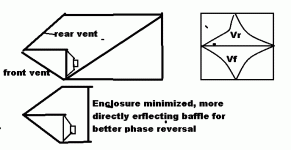
Larger rear volume/area. Anyone ever tried a rear vent?
So essentially it's a term 'invented' recently by a guy writing a book for something that long pre-dates WWII 😀
And while I'm conversant with various meanings of 'detuned', I see no way it can apply to speakers mounted on an open baffle?.
I've been in the electronics trade a LONG time, and that term was never used for baffle mounted speakers.
Yes, that's pretty much what he did. Reminds me of how "wheatstone bridge" came about. And I find it valid as it's essentially negating any tuning of the enclosure. Same word, different application. Define "scale". I can think of 7 right off.
Is there anything in his book that you can point to and say specifically is incorrect and the term should not apply?
- Status
- Not open for further replies.
- Home
- Live Sound
- Instruments and Amps
- Detuned Demystified
